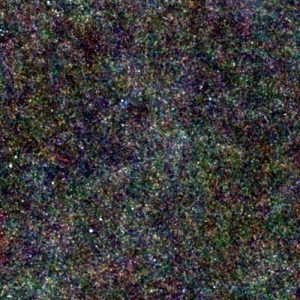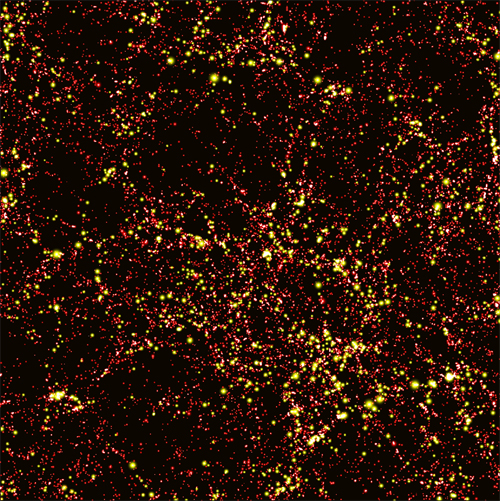| Basic Information | |
| What is this? | A simulation of the distribution of dark matter in the early Universe |
| Where is it in the sky? | The simulation is compared to an area of the sky in the constellation of Ursa Major |
| How big is it? | The simulation is of a volume of the Universe several hundred million light years across |
| How far away is it? | The dark matter is simulated as it was when the Universe was around 3 billion years old |
| What do the colours represent? | The red shows clumps of dark matter, while the yellow highlights those clumps which are large enough to form stars |
Downloads
See this object in:

This simulation shows an area of the Universe as it was around 3 billion years after the Big Bang. If it were traced forward to today, it would be several hundred million light years across. The simulation shows the distribution of dark matter. There is around 5 times as much dark matter as normal matter – the stuff which up people, planets, stars and galaxies – in the Universe, and while it can’t be seen by any telescope, it does give a gravitational tug on the matter we can see.
Galaxies like our own Milky Way formed billions of years ago from clouds of gas collapsing under gravity. The way in which the gas collapses depends on the amount of dark matter in the neighbourhood. “If you start with too little dark matter, then a developing galaxy would peter out. But if you have the just the right amount of dark matter, then a galaxy bursting with stars will pop out.” said astronomer Asantha Cooray of UC Irvine in California, who led this research appearing in the 24th Feb 2011 issue of the journal Nature. This research was part of the HerMES project, which uses Herschel to look at these distant galaxies and is led by Seb Oliver, of University of Sussex, and Jamie Bock, of NASA’s Jet Propulsion Laboratory. Herschel is a flagship mission of the UK Space Agency, which funds the UK’s involvement in the UK-led SPIRE instrument.
The right amount of dark matter turns out to be a mass equivalent to around 300 billion Suns. For reference, the dark matter surrounding our Milky Way galaxy weighs in at the equivalent of roughly 1 trillion Suns.

The team used Herschel to measure infrared light from massive, star-forming galaxies in the distant Universe, using images of two regions of the sky in the constellation of Ursa Major (the Lockman Hole and GOODS-North). The huge distance means that light has taken 10-11 billion years to cross the Universe, so the galaxies are seen when the Universe was only around 3 billion years old.
Astronomers think that these and other galaxies formed inside halos, or clumps, of dark matter, and were forming stars hundreds of times more rapidly than galaxies in today’s Universe. The rapid star formation produced a lot of interstellar dust, which is what is glowing at the far-infrared wavelengths observed by Herschel.
“This measurement is important because we are homing in on the very basic ingredients in galaxy formation,” said Alexandre Amblard of UC Irvine, lead author of the Nature paper. “In this case, the ingredient, dark matter, happens to be an exotic substance that we still have much to learn about.”
In this new study, Hershel was able to uncover more about how this galaxy-making process works by acquiring maps of the infrared light that comes from collections of very distant, massive star-forming galaxies. The most distant galaxies are so far away that Herschel cannot see them individually, but rather sees the pattern as their light blurs together. This pattern of light, called the cosmic infrared background, is like a web that spreads across the sky. Because Herschel can survey large areas of the sky very quickly with high resolution, it was able to create the first detailed maps of the cosmic infrared background.
Giant clumps of dark matter act like gravitational wells to collect gas and dust needed for making galaxies. The gas and dust become much denser as they fall into the well, allowing new stars to form. When there are eventually enough stars, a galaxy is born.
But this only happens if there is enough dark matter to keep the gas and dust clumped together – if there is enough dark matter, several galaxies will form in the same clump. The maps showed that the galaxies are more clustered into groups than previously believed, which means that they tend to lie in larger clumps of dark matter – in those clumps which contain more matter than around 300 billion Suns.
“I find it amazing that with these results we are able to understand the link between mass and star formation” said Seb Oliver. “Particularly when the mass can never be seen, the star-formation is shrouded in dust and invisible to normal telescopes, and only 15% of the dust emission can be resolved into individual galaxies – heroic work!”

